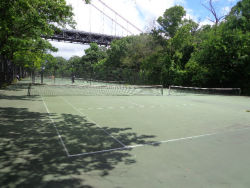Fort Washington Park
Lily Brown Playground
This playground honors the memory of Lily Brown (1913-1996), a community leader and lifelong resident of upper Manhattan. She was born on August 7 in Washington Heights. She attended George Washington High School and City College before earning a Masters degree from Bank Street College. Brown worked as a teacher and remedial reading specialist for emotionally disturbed children, and she devoted her free hours to extensive neighborhood volunteer work.
Brown was not only a hard worker but also a community activist. She was always willing to push, urge, and make herself heard until her neighbors and City officials did their part as well. One of Brown’s first projects was organizing the St. Nicholas Terrace Improvement Association in her housing complex on West 130th Street. With her leadership, the organization induced Parks Commissioner Robert Moses (1888-1981) to rebuild the local playground.
In 1964, Lily Brown moved back to Washington Heights, to the River Terrace Apartments, where she lived for the rest of her life. At her new home, she formed the River Terrace Neighborhood Committee, which she led for 25 years. Aware, though, that the efforts of a single apartment-house complex would not be sufficient for the needs of the community at large, Lily Brown organized the Neighborhood Action Coalition, which united several such smaller groups to work for general civic improvement. The coalition met with elected officials, community board members, and representatives of many City departments to voice their needs and to propose plans of action.
Semi-annual clean-up drives, public ‘green-up’ plantings, Merchant of the Month awards for sidewalk cleanliness, bus shelter replacement, highway billboard removal, and park and playground renovation were just some of her many projects. Despite all her success, Brown is remembered as a “most modest person,” never seeking personal credit for her numerous achievements. Her name never appeared on the letterhead of the Neighborhood Action Coalition, and she signed herself “co-chairperson,” though no one ever knew of another co-chair.
The reconstruction of this playground was one of her projects. In 1987, its rundown condition moved her to set up a Playground Committee to study and remedy the situation. The three-member committee drafted a report proposing significant site improvements. When Lily Brown died on June 5, 1996, after a long illness, City Councilman Stanley Michels proposed that the playground be renamed in her honor. Dedicated on November 16, 2001, Lily Brown Playground is a fitting memorial to a woman who devoted her life to civic and social action, and the improvement of neighborhood spaces.
The section of Fort Washington Park that houses the playground, at 162nd Street and Riverside Drive, was added in 1925 as one of the first five parcels which made up the majority of the park. East of Riverside Drive, away from the main body of the Park, the playground lies on a sloping embankment, supported by a concrete retaining wall. In the late 1990s the area was undermined by water main breaks and erosion and the playground was closed for nearly two years because of hazardous conditions. A 1.6 million-dollar renovation in 2001-2002, sponsored by Councilman Michels, upgraded the entire playground. The brick public restroom was renovated and the fencing and retaining wall restored. New play structures, kindergarten swings, game tables, painted games, a spray shower, and benches attract visitors of all ages.
Check out your park's Vital Signs
Clean & Safe
Green & Resilient
Empowered & Engaged Users
Share your feedback or learn more about how this park is part of a
Vital Park System

Know Before You Go










